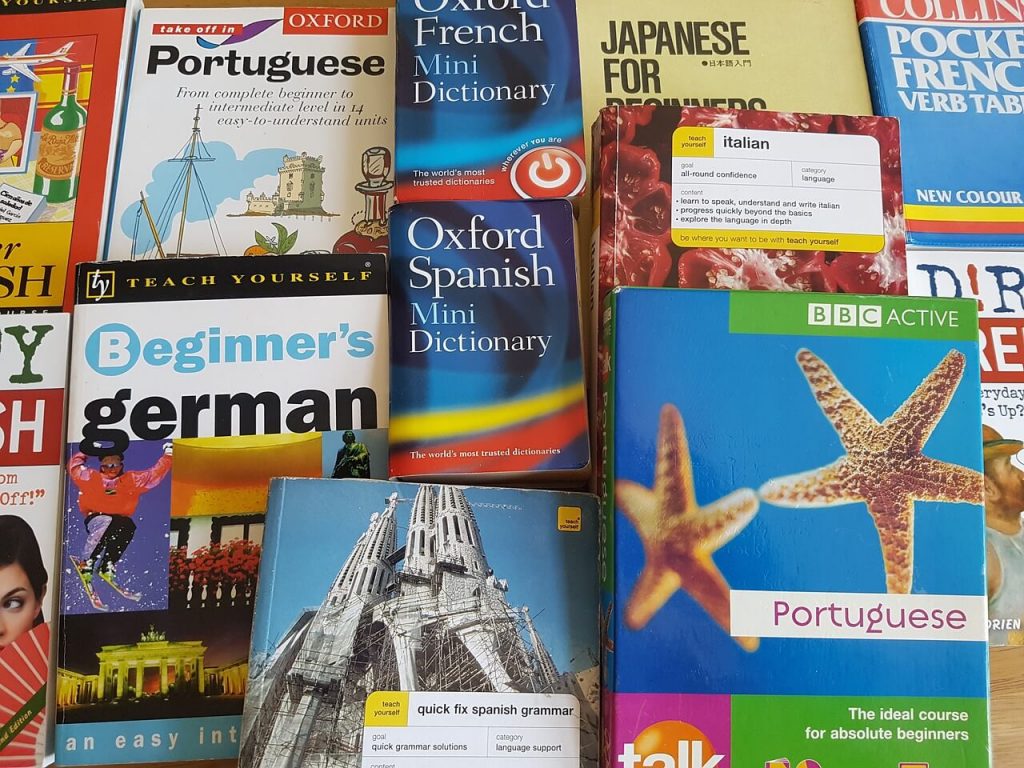How We Learn Languages
This is a post on everything we’ve learned from studying many languages. We’ve been doing languages for decades, and have a methodology and mindset that we’ve used that brings us into polyglot and hyper-polyglot levels.
Everything is relative, of course. I’m frequently humbled by true experts in many of the languages that I think I speak “well”. In fact, humility is the most important principle!
But because many people are curious how they can add more languages to their repertoire, we’re sharing here everything that we’ve learned. We’ll keep this post updated when we can.

“If I had five minutes to chop down a tree, I’d spend the first two and a half minutes sharpening the axe.”
– Unattributed, not actually George Washington so don’t tell me it is
At this point, I speak nine languages and Jo speaks five. By “speak” I mean we can talk for about an hour in various social situations without having to revert to English or another language. You can see us speaking Egyptian Arabic here or Swahili here, for example.
In our early days of language learning, we took a lot longer to get to the same conversational point. Now, we’ve learned a lot about learning and want to share our tips on language-learning with you — plus lessons we’ve learned from the mistakes we made.
Overview — What We’ve Learned about Learning Languages
Here’s everything we’ve learned about learning new languages in a nutshell.
- Get in the right mindset — Believe that you can make progress, and focus on the journey rather than the destination
- Choose one language or dialect and be persistent — avoid the temptation to study two languages at once (unless you’re a very advanced language learner)
- Set realistic targets (and be flexible) — decide what’s really important to you. Reading? Speaking? And don’t get bogged down.
- Learn faster with a tutor — a great tutor can catapult your progress further ahead. Going alone is cool, but don’t be a hero if you can afford some help.
- Get the right tools — The right books, the right flashcard systems — it makes a ton of difference.
- Start with a conversation — The longer you put off speaking, the longer you’ll miss out on learning the most important things (unless your priority isn’t speaking)
- Learn the pronunciation and sounds — It’s easy to not say anything out loud and never know you’ve always been saying something wrong
- Learn the alphabet and how to read basic words — there’s no language (even Chinese) where you can get away without learning an alphabet/character
- Record giving speeches or reading sentences — recording yourself is a great acid test and also something to refer back to, to see how far you’ve come!
- Master “bread and butter” basic phrases and structures — make sure you can get through the first minute or two of any social conversation without really thinking about it
- Memorise groups of vocabulary — fruits, verbs, adjectives… the basics
- Learn what’s around you and what you do every day — make sure you can describe your everyday life.
Get in the Right Mindset
Probably the most important part of learning is believing we can learn.
We’re only dedicating this small part to it because this is repeated in so many places. But we’ve realised we’ll get nowhere without a strong belief that we can and will progress. We need to be in the right mindset to learn.
I mention this because people often defeat themselves at the outset of any endeavour. If you’ve ever thought “I’m just not good with languages”, you need to excise those thoughts from your brain. It’s very different to saying “I’ve got challenges, but I’m working through them!”. Humility is acknowledging that we have challenges (and we all do), and it actually helps us, because it tells us where to focus our efforts.
Here’s a brief summary of what we do to get in the mindset of language learners.
- We tell ourselves “I speak xxx language.” Not “I speak a little” or feeling apologetic about not speaking it.
- We immediately start learning in the morning. (after coffee)
- We often record ourselves speaking in that language (even if just for ourselves). Sometimes it goes online, sometimes into a flashcard, or sometimes it just goes in our own archives.
The frustrating thing is that it’s so easy to hit a roadblock. One awkward interaction can set our confidence back a lot. For example, when you try as you might to speak to someone in a language, but they speak back to you in English. (See here for some tips on that situation.)
Probably the best thing we can do: encourage each other and others. It’s not where we get to that counts — it’s that we’re trying
Choose One Language or Dialect and Be Persistent
For example, if learning Arabic, choose a format, like Modern Standard Arabic or Egyptian Arabic, and stick with it.
Note this includes two commitments: pick one language, and stick with it.
Pick one language or dialect
We’re always tempted to chop and change languages. We want to learn two (or more) languages at once.
Part of the reason we try learning multiple languages at once is that our minds are being activated into a language-learning mode. As our brain gets fitter we start to feel like we can do anything and want to take more on.
The problem is that many studies (and our own experience) show that studying multiple languages at once nearly always results in learning both languages more slowly than learning them separately.
The second reason we want to to learn two languages at once is that our minds are looking for easy ways to solve the problem. “Can’t remember a word in Italian? Well, it’s this in Spanish. Happy now?” The mind is trying to give you an answer to a problem… which will solve an immediate question (how to say a word) but not the question we actually have (how to say it in the language in question).
The final reason is that it’s easy to get excited. Some friend is learning Russian and we think that’s cool. We recall our mother tongues are Korean and Persian and want to work on those. But it is usually not in our best interests to do this. Languages are hard — there’s usually enough to focus on in just one.
Unfortunately, and we say this from experience, knowing 1/4 of four languages is equivalent to knowing zero of any languages.
Stick with it
Related to the above, it’s easy to give up whenever you get to one of those times when things get hard. Learning languages always means passing a few event horizons of difficulty. The first hundred words are fine. Then you get to
- “Wah there are so many words!”
- “Wah the grammar is so hard!”
- “Wah I can’t pronounce this!”
- “Wah I can’t understand anything!”
We have to know in advance we’re going to hit those challenges, and learn to persevere through them.
Set Realistic Targets (and Be Flexible)
It’s critical to set a realistic target. “Fluency” or “conversational fluency” is too vague. Using the European standards for language fluency is better, but they’re not for everyone.
Set a target that makes sense like
- “I want to be able to understand a song, maybe not at first pass but after reading the lyrics and looking up a few words.”
- “I want to be able to go to a study group with friends and not have to use English.”
Especially as we’re setting time limits on how much we learn, we have to set super-realistic goals for how fluent we can get in one to two months, and be happy with hitting that limit.
We’ve set our target as being “fluent enough to keep learning in that language”. This means, being able to ask what a word means in a language and understand the reply.
Note all the things that this target is NOT:
- Listening in to strangers (limited benefits anyway; they’re never talking about me. I guess I’m not that interesting). They usually speak colloquially and quickly and that’s a whole other level
- Reading the newspaper or listening to the news. In some languages this is largely the same and just needs extra vocabulary (‘earthquake’, ‘attack’ and ‘president’ get you pretty far), but in case it’s quite different like for a colloquial language, it’s not a priority.
- Reading poetry. We don’t often read poetry in English, so this isn’t our goal.
Any of the above goals might be yours, so just know what you want to do.
You have to also be flexible with your targets. Want to get fluent in three months? That’s great, but it might end up taking a year. Don’t beat yourself up about it. In three months you’re still way ahead of where you were in the past.
Learn Faster with a Tutor
Get a tutor online for as little as $4/hour from the best out there — italki. (Use this link for $10 credit after your first purchase of credits.)
One thing we’ve learned over the years is that a great tutor or coach can be life-changing. We’re huge fans of italki for all the reasons in this article.
In our earlier years, we thought we could teach ourselves anything. This is true to a degree, but in my twenties, I had infinite time, whereas in my thirties I know my time is about to expire with the onslaught of children (and eventually, death!). It was when I learned Chinese with a few great teachers (and one in particular) in China that I learned the value of a teacher: three hours of study a day with one teacher would progress me as much as several days of independent study. Think about how much your time is worth, and invest in your own education.
Yes, tutors can get expensive. Even online, you can pay $20/hour for a professional teacher, or as little as $5 an hour for a basic conversation partner. To make the most of a basic conversation partner here are a bunch of tips we’ve learned.
And here’s what we think makes a great tutor
- A great tutor takes the time to get to know your goals, and maybe help you set them. They understand your interests (e.g. comedy, music, business) and find content that’s relevant, and specifically ignore content that’s irrelevant.
- A great tutor only talks to you. Basic tutors will just get you to read out of a book and correct your reading, or ask you to repeat phrases after them. But a tutor will engage you in conversation, take notes, and then set homework on what they observe the patterns of your mistakes to be.
- A great tutor creates custom material for your interests. At a basic level, textbooks are usually the best resource (there are so many!). But they won’t blindly go through them; they’ll select the right chapters, and won’t automatically go to the next level textbook when you’re done.
This is a huge topic and one we’ll explore in more detail. But tell us if you’ve had a great tutor. What made them great?
Get the Right Tools
It takes time and experimentation to understand the right tools. We’ve wasted a lot of time trying apps, notebooks, textbooks, CDs (what’s a CD? Well it’s a thing that replaced a cassette, which is actually where I started), lists, flashcards (physical and app-based), various dictionaries… and yes, experimentation is part of the process.
We have a very old-school approach to learning that works for us. We like to use
- A textbook, the “Teach Yourself” kind. Electronic version preferably, with online audio resources, or an online course
- Flashcard decks — you can’t live without them. We use Anki (it’s free)
- A sentence bank (Glossika) to learn critical sentences
- A way to set up teacher appointments. We use iTalki.
- Selective apps but only at the beginning stages for basic alphabet and vocabulary
Much more detail here on tools we like to use.
Things we’ve learned don’t work (for us):
- Past the beginning stage, most apps including Duolingo, Memrise etc. It’s fun, but just creates a false illusion of progress.
- Chatting apps that don’t go to conversation. These never go anywhere and don’t help much.
- Fancy/expensive software like Rosetta Stone. People advertise them but that’s just for sales commissions.
Start with a conversation
We always start with an easy tool, but then when we have our first conversation… that’s when things REALLY start. It always goes like this:
“Hi! I’m Dana.” [Oh cripes how do I say all the many other things I need to say right now, like “Nice to meet you”]
At that point, we always realise how much you need to learn. Then we have a second conversation and learn even more. There’s no limit to how many of these we can stack up. So if we have a teacher, we can have the same conversation over and over until we nail it and all the variations. Why not?
The thing is, this conversation stops being scary. I believe we only get more and more used to the feeling of being scared but also conditioned to understand the benefits.
Learn the pronunciation and sounds
I really like the way French people express that they don’t know something. It can only be described as:
‘Eh, ben… [farting sound]’ (accompanied by a short shoulder shrug)
Seriously, like a small farting sound through pursed lips. It sounds so silly if you say it in ANY OTHER LANGUAGE. But say it in French and it’s super French. Try it!
Sounds are an easy thing to drill, but also enjoyable. Make the sounds! Most languages have unique sounds.
In the past, we’ve suffered from not just drilling difficult-to-pronounce sounds (and words in them).
Some common ones you’ll encounter:
- The trilled R like in Spanish, particularly vexing after an L, like in alrededor
- The ZH sound like in French (rouge)
- The hard D, B, S and T in Arabic (same as standard but harder)
- Tones in Chinese, plus the X sound that’s halfway between an English SH and S
The list goes on. There are some that I find it very hard to master (and it bugs me).
One hack we’ve learned is to just pretend we can make the sound… even mimicking the accent in English helps. I like to find a muse, someone who I enjoy listening to, and then copy them. In my head, I’ll be them, mimicking their accent and intonation. After a while, it becomes natural.
Learn the alphabet and how to read basic words
We’ve in the past learned to speak only (e.g. with Hebrew back in the late nineties), but almost immediately got to a point where we had to learn to read and write. And the benefits are TREMENDOUS. In every language other than Chinese or Japanese, it’s way easier to learn to read and write than you may think.
We did an exhaustive review of the most popular writing systems here. But in general here’s why we’ve learned you should learn to read and write:
- You’ll learn more quickly. Sometimes without even trying. E.g. I unwittingly learned the Estonian words for shop (pood), cheese (juust), chicken (kana) and open (avatud) without even trying (or wanting to).
- You need to read menus. You can eat food. It’s surprising how little you need to know – just meats, maybe a few vegetables and core food names. You’ll learn out of desperation, eventually – it doesn’t take going far off the beaten track to get to a place without an English menu, even in a well-developed country (as we learned in Helsinki over the weekend). If you’re on a special diet, this will be even more critical. Besides, it’s really fun to read menus.
- Street signs. You won’t get lost. This includes using Google Maps when you’re in the country and street and area names come up primarily in the local language.
- Apps. Some places have their own apps, much better than what Google can provide. China is a primary example of this, where there is no Google and you’ll be using Tencent Maps or Baidu Maps.
- Communicate. You can understand notes, text messages and blog comments written to you by your friends in another country.
- It’s really fun to write another language!
Can’t emphasise the last one enough. It’s so cool to see another script coming out of your hand.
Record ourselves giving speeches or reading sentences
As we learned Arabic, we recorded Arabic process videos (see them on our channel here, including our final 60-day video)
We enjoyed the process of learning sentences and phrases fluently. They let us use those sentences naturally in conversation, or to give speeches and use them without worrying about conjugation.
We decided, as a result, to start learning and recording ten sentences a day, in any language we’re learning. This makes us learn more vocabulary, but it also forces us to get more fluent.
We have to refine this process further. For example, how often do we go back and listen to old sentences? Should we record them with English too, to remind ourselves what they mean? Should we record them individually, like flashcards? All in progress!
Learn “bread and butter” basic phrases and structures
Despite learning a whole bunch of formal structures, we keep finding, again and again, that in day to day life, language is mostly things like
- “Excuse me, is it OK if I…?”
- “Excuse me (to get past someone)”
- “Hey, I don’t think that’s a good idea”
- “What the heck is that?”
- “Hey where’s my…? It was just here”
My brother Riaz once put it elegantly, that the phrase “Argh! My pen just rolled off the table and now it’s fallen under my chair” is really complicated to say. How do you exclaim “Argh”, for one thing? But think how easily a native speaker can say phrases like that. That’s where you need to get to.
Memorise groups of vocabulary
Sometimes we just have to memorise stuff. And there’s no two ways about it… no real ‘fun’ way to do it. There’s just a practical way, and that’s the best way.
Here are eleven things we need to know in everyday life… I think this is all the things.
- Greetings (“Yo!”)
- Core phrases – purchasing things, getting directions (“how much is it? which way is the train station?”)
- Places (bus stop, school, building, church)
- Numbers (at least to 1000, beyond that it usually gets easier anyway)
- Currency/coins (colloquially). (E.g. a dime, two bucks)
- Fruit, vegetables, meat (markets)
- Food and drink you’ll buy
- Professions (teacher, police officer)
- Vehicles (motorcycle, car, bicycle)
- Around 100 common verbs (run, walk, go, turn, stop, start, get on, get off… basically all the ones that come up in everyday life!)
- Around 30 common adjectives. They come in pairs! (big, small, long, short, far).
You can’t really rely on phrasebooks for these unless they’re very colloquial. Try hard to actually learn the words people use in everyday life. For example, a phrasebook will teach you that in Arabic countries you greet with “ahlan wa sahlan”. Technically correct, but you’re much more likely to hear a colloquial version depending on where you are.
Similarly, for common vehicles, foods you’d order, currency word (think how often you hear ‘dollars’ vs ‘bucks’ informally) you’ll have to dig a bit. These days, Youtube is your friend.
If you’re looking for a list of useful words, check out our 80-20 vocabulary list.
Core hack… you don’t need to learn complicated directions like every textbook teaches you. Most people just wave their hands and say ‘that way’ or ‘go straight’.
Build sentences and phrases with this everyday vocab until it becomes natural.
Learn what’s around you and what you do every day
My friend Ralph, who was German but learned English fluently while living in a tiny village in the south of Germany, once gave me a great tip on learning languages: Talk to yourself and describe things around you.
This starts with pointing at things and calling them names. Cup. Street. Tree. Sky. Then getting more granular… Blue sky. Nice day. Full cup.
Eventually, it becomes translating things. There are many trees next to the road. The cup is full of coffee and it’s too hot.
These are super simple phrases and don’t demand much vocabulary, but do demand that you have it on constant recall.






